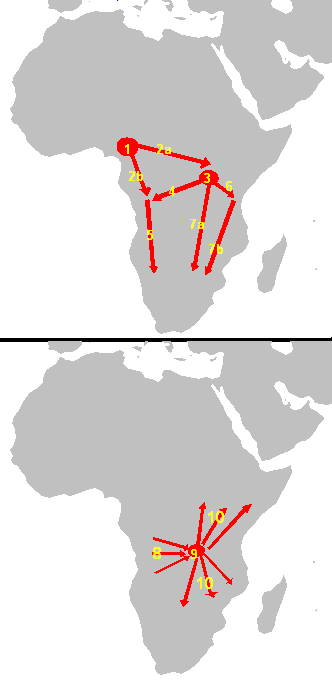
Back توسع البانتو Arabic Espansión bantú AST বান্টু সম্প্রসারণ Bengali/Bangla Expansió bantu Catalan Bantu expansion English Expansión bantú Spanish Bantuekspansio Finnish Expansion bantoue French Civiltà bantu Italian Bantų migracijos Lithuanian
Migrasi Bantu adalah istilah yang mengacu kepada peristiwa migrasi penutur asli kelompok bahasa proto-Bantu yang berlangsung selama ribuan tahun.[1][2] Bukti utama yang menunjukkan terjadinya peristiwa ini berasal dari cabang ilmu linguistik, yaitu bahasa yang digunakan di Afrika Sub-Khatulistiwa yang sangat mirip satu sama lain. Upaya untuk melacak rute migrasi yang tepat dan mengaitkannya dengan bukti-bukti arkeologi dan genetik masih belum konklusif; dengan demikian banyak aspek migrasi yang masih diragukan atau sangat diperdebatkan.[3] Terdapat dua gelombang migrasi Bantu, dan yang pertama melintasi daerah hutan Kongo.[4]
Inti linguistik dari rumpun bahasa Bantu, sebuah cabang dari keluarga bahasa Niger–Kongo, terletak di wilayah Kamerun dan Nigeria yang bersebelahan. Dari wilayah ini, migrasi dimulai sekitar 3.000 tahun yang lalu, dengan satu gelombang pergi ke Afrika Timur, dan lainnya ke selatan di sepanjang pesisir Afrika dari Gabon, Republik Demokratik Kongo, Angola, atau wilayah pedalaman di sepanjang sungai-sungai yang mengalir dari sistem Sungai Kongo dari selatan ke utara. Migrasi akhirnya mencapai Afrika Selatan mungkin sekitar tahun 300 M.[5][6][7][8][9][10][11][12]

2 = sekitar 1500 SM migrasi awal
2.a = Afrika Timur, 2.b = Afrika Barat
3 = 1000-500 BC inti Urewe dari Afrika Timur
4–7 = pergerakan ke selatan
9 = 500 SM–0 inti Kongo
10 = 0-1000 Masehi fase terakhir[13][14][15]
- ^ Clark, John Desmond; Brandt, Steven A. (1984). From Hunters to Farmers: The Causes and Consequences of Food Production in Africa. University of California Press. hlm. 33. ISBN 0-520-04574-2.
- ^ Adler, Philip J.; Pouwels, Randall L. (2007). World Civilizations: Since 1500. Cengage Learning. hlm. 169. ISBN 0-495-50262-6.
- ^ Berniell-Lee, Gemma; Calafell, Francesc; Bosch, Elena; et al. (2006). "Genetic and Demographic Implications of the Bantu Expansion: Insights from Human Paternal Lineages". 26 (7). doi:10.1093/molbev/msp069. PMID 19369595.
- ^ Pollard, Elizabeth; Rosenberg, Clifford; Tignor, Robert (2011). Worlds Together, Worlds Apart: A History of the World: From the Beginnings of Humankind to the Present. New York: Norton. hlm. 289. ISBN 978-0-3939-1847-2.
- ^ Vansina, J. (1995). "New Linguistic Evidence and ‚The Bantu Expansion'". Journal of African History. 36 (2): 173–195. doi:10.1017/S0021853700034101. JSTOR 182309.
- ^ Tishkoff, S. A.; Reed, F. A.; Friedlaender, F. R.; et al. (2009). "The Genetic Structure and History of Africans and African Americans". Science. 324 (5930): 1035–44. doi:10.1126/science.1172257. PMC 2947357
 . PMID 19407144.
. PMID 19407144.
- ^ Plaza, S; Salas, A; Calafell, F; Corte-Real, F; Bertranpetit, J; Carracedo, A; Comas, D (2004). "Insights into the western Bantu dispersal: MtDNA lineage analysis in Angola". Human Genetics. 115 (5): 439–47. doi:10.1007/s00439-004-1164-0. PMID 15340834.
- ^ Coelho, M; Sequeira, F; Luiselli, D; Beleza, S; Rocha, J (2009). "On the edge of Bantu expansions: MtDNA, Y chromosome and lactase persistence genetic variation in southwestern Angola". BMC Evolutionary Biology. 9: 80. doi:10.1186/1471-2148-9-80. PMC 2682489
 . PMID 19383166.
. PMID 19383166.
- ^ De Filippo, C; Barbieri, C; Whitten, M; et al. (2011). "Y-chromosomal variation in sub-Saharan Africa: Insights into the history of Niger–Congo groups". Molecular Biology and Evolution. 28 (3): 1255–69. doi:10.1093/molbev/msq312. PMC 3561512
 . PMID 21109585.
. PMID 21109585.
- ^ Alves, I; Coelho, M; Gignoux, C; et al. (2011). "Genetic homogeneity across Bantu-speaking groups from Mozambique and Angola challenges early split scenarios between East and West Bantu populations". Human Biology. 83 (1): 13–38. doi:10.3378/027.083.0102. PMID 21453002.
- ^ Castrì, L; Tofanelli, S; Garagnani, P; et al. (2009). "MtDNA variability in two Bantu-speaking populations (Shona and Hutu) from Eastern Africa: Implications for peopling and migration patterns in sub-Saharan Africa". American Journal of Physical Anthropology. 140 (2): 302–11. doi:10.1002/ajpa.21070. PMID 19425093.
- ^ "Carte Blanche > M-Net". Beta.mnet.co.za. Diarsipkan dari versi asli tanggal 7 January 2012. Diakses tanggal 2011-12-31.
- ^ Bousman, C. Britt (June 1998). "The Chronological Evidence for the Introduction of Domestic Stock into Southern Africa". 15 (2). JSTOR 25130649.
- ^ "A Brief History of Botswana". Thuto.org. 2000-09-19. Diakses tanggal 2011-12-31.
- ^ Andrej, Isabella (1998) (dalam bahasa German). Historischer Überblick (Tesis). Vienna, Austria: University of Vienna. http://elaine.ihs.ac.at/~isa/diplom/node59.html. Diakses pada 2011-12-31. Diarsipkan 2007-10-16 di Wayback Machine.